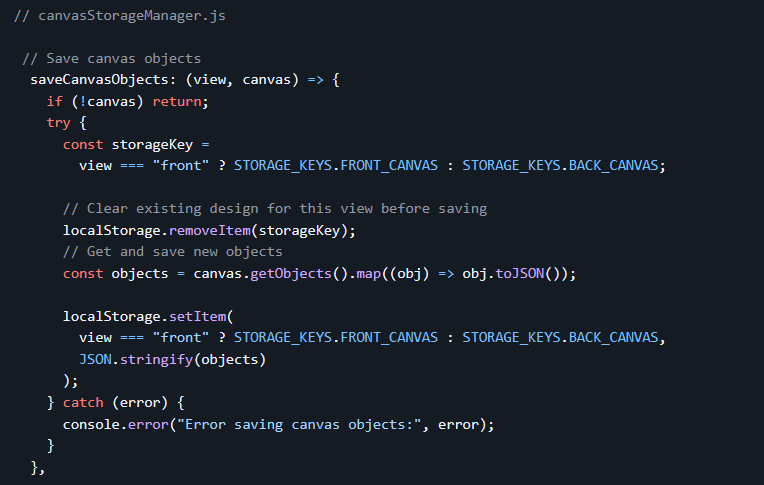🔖 Introduction
About the project
The T-Shirt Design Studio is an interactive web-based platform that combines powerful 2D design tools with real-time 3D visualization, enabling users to create custom apparel designs with unprecedented ease and precision. This project addresses the growing demand for personalized fashion by providing an intuitive yet sophisticated design interface that bridges the gap between professional design software and consumer-friendly applications.
The platform empowers users to create custom t-shirt designs through an innovative dual-canvas system that shows both front and back views, with all changes instantly reflected in a photo-realistic 3D preview. By leveraging modern web technologies like React.js, Three.js, and Fabric.js, the project delivers a seamless design experience across all device types, allowing users to manipulate text, images, and shapes with professional-grade tools while immediately visualizing the end product in three dimensions.
The result is a comprehensive design solution that democratizes custom apparel creation, giving both casual users and design professionals the ability to bring their creative visions to life with confidence before production.
🤔 Problem space
Problems to solve/Requirements to Create
Custom t-shirt design platforms often provide either basic 2D design tools with limited visualization or complex 3D tools with steep learning curves. Users struggle to accurately envision how their designs will look in real life.
👉 Problem: Disconnection between 2D design and 3D visualization
Users have difficulty imagining how their 2D designs will translate to an actual three-dimensional garment, leading to customer dissatisfaction with final products and increased return rates.
Current solution
Most existing platforms either offer only 2D mock-ups with flat templates or separate 3D previews that don't update in real-time, forcing users to switch between different views and imagine the final result.
How do we know it is a problem
Why solve these problems?
Reducing the gap between expectation and reality directly impacts return rates and customer satisfaction
First-mover advantage in creating a truly accessible 3D design experience would establish market leadership
Goals
Company objective 🎯
💡 To create a modern custom apparel design platform that democratizes professional-quality design capabilities while providing accurate visualization, leading to higher customer satisfaction and reduced returns.
Project goals
Build an intuitive dual-canvas system that synchronizes with a real-time 3D model to bridge the 2D-3D gap
Develop a responsive design system that provides a consistent experience across all device types
Create a comprehensive yet accessible set of design tools that empower users of all skill levels
Implement efficient state management and storage solutions to ensure a seamless user experience
🌟 Design space
UI Design
The T-Shirt Design Studio features an intuitive split-screen interface that balances powerful design capabilities with ease of use.
Design system 🎨
The project utilizes a hybrid design system combining Shadcn/UI components with custom-built design elements specifically for canvas interaction. This approach provided several advantages:
Shadcn/UI delivered consistent, accessible UI components for navigation, buttons, dropdowns, and modals while allowing customization to match the project's aesthetic.
Custom canvas controls were developed to maintain consistency with Shadcn/UI while providing specialized functionality for design manipulation.
Development Phase
Technology Stack Selection
💡 Discuss why the Technologies and Tools you used are chosen
1. Frontend - React.js
Component Architecture: Facilitates reusable and modular UI elements, crucial for a design tool with multiple interactive components.
Virtual DOM: Enables efficient rendering of the constantly changing canvas state without performance issues.
Ecosystem Compatibility: Seamlessly integrates with Fabric.js, Three.js, and other libraries central to the project.
2. Canvas Management - Fabric.js
Object-Oriented Canvas: Provides robust object management for manipulating design elements.
Event Handling: Offers sophisticated event system for interactions like dragging, rotating, and scaling.
Serialization: Facilitates converting complex canvas states to JSON for storage and restoration.
Text Handling: Delivers powerful text manipulation capabilities with support for multiple fonts and styles.
3. 3D Rendering - Three.js with React Three Fiber
WebGL Abstraction: Three.js provides high-level access to WebGL for 3D rendering.
React Integration: React Three Fiber bridges Three.js with React's component system for declarative 3D development.
Performance: Optimized rendering pipeline for smooth real-time 3D visualization even on moderate hardware.
Material System: Sophisticated material handling for realistic fabric visualization.
4. State Management - Redux Toolkit & Context API (Hybrid Approach)
Separation of Concerns: Redux for serializable UI states, Context API for non-serializable canvas objects.
Performance Optimization: Prevents unnecessary re-renders by isolating canvas operations from general UI state.
Persistence: Redux states easily persist to LocalStorage while canvas states require specialized serialization.
5. Styling - Tailwind CSS with Shadcn/UI
Utility-First Approach: Tailwind enables rapid UI development with minimal CSS overhead.
Component Library: Shadcn/UI provides accessible, consistent UI components while maintaining styling flexibility.
Theme Customization: Supports dark mode and custom theming for the design environment.
Key Features of the Software
1. Dual-Canvas Design System with 3D Synchronization
Created a custom Canvas Manager service that maintains separate Fabric.js instances for front and back views while sharing a common state management system.
2. Real-Time 3D Visualization Engine
Built a Three.js-based rendering system with React Three Fiber that provides photorealistic visualization of designs on a 3D t-shirt model.
3. Advanced Text Manipulation System
Developed a comprehensive text editing module with typography controls like font, color, and size.
4. Persistent Storage Architecture
Created a storage system with local storage that maintains design state across sessions.
Challenges Faced and Solutions
Problem: Complex Canvas State Management
Initially, storing the Fabric.js canvas state in Redux proved problematic due to:
Circular references in canvas objects
Non-serializable data structures
Performance implications with complex designs
Solution:
Implemented a hybrid state management approach (Redux + Context API)
Separate state management for different concerns
Redux: UI states (colors, views, selections)
Context API: Complex canvas operations
LocalStorage: Design persistence
Problem: Design Persistence Across Views
Designs were disappearing during:
Front/back view switches
Component remounts
Page refreshes
Solution:
Developed a custom storage management system:

Future Vision / next steps
Planned Features



Get visibility from recruiters & peers
Build your portfolio & personal brand
Connect with like-minded developers
